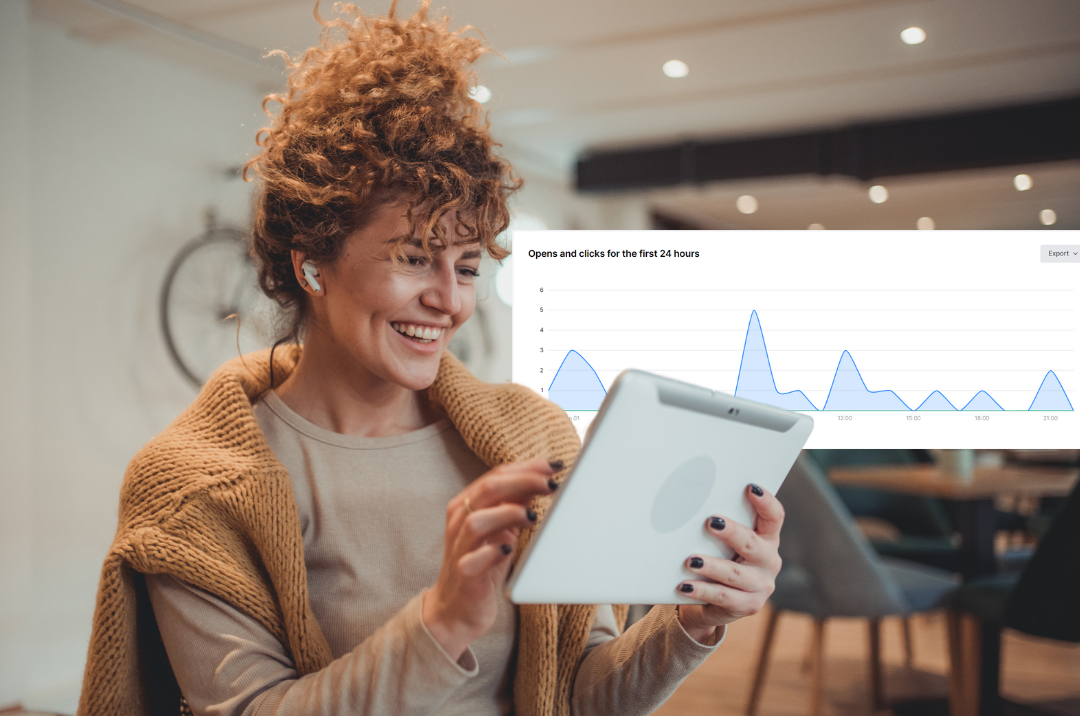Wondering when is the ideal moment to shoot off email newsletters this year? We often hear this question, so we delve into the information to provide some insights and discover solutions.
You have an important question on your mind! You want to know the perfect time to send email newsletters because you don’t want to bother your readers when they’re busy with work or daydreaming about their weekend plans.
The idea is to pick times when people are free and in the right headspace to read your email newsletters. You want to choose times that give you the best chance for people to engage with your email newsletters.
But here’s the thing – is there a time when everyone is ready to receive email newsletters? And if there is, wouldn’t everyone end up sending their email newsletters at that exact time? That wouldn’t work out too well.
Before we delve into deep thoughts, let’s focus on the concrete information, also known as the data. We’ll discuss:
Best Days in the week to send email newsletters
Some past data and tips to get more email engagements.
Why does the email newsletter timing matter for the business?
- Tools for email marketing the most effective time.
We want to help you figure out this million-dollar question!
In a nutshell 💡:
We checked out more than a million email marketing campaigns from the US, UK, Australia, and Canada. Here’s the lowdown:
- What’s the popular day for hitting the send button?
Most email marketers like for Tuesday, Wednesday, and Thursday.
2. Which day gets the most people opening their emails?
Thursday wins the prize for the highest open rate, with Monday not far behind.
3. When during the day do people open emails the most?
The hot times are between 9AM-12PM, and another spike between 12PM-3PM.
Consider what common beliefs suggest about the best times to send emails
To begin, imagine you’re one of your subscribers. Reflect on their daily schedules, behaviors, and attitudes. While you may not have all the data, you likely have a good understanding of your target audience. When is the most probable time for them to interact with your email campaigns?
Usually, their weekly routine looks something like this:
Monday
Many people believe it’s not a good idea to send email newsletters on Mondays. Why? Because most folks feel a bit down on Mondays, facing the end of the weekend. When they get to work, their inboxes are filled with emails from the past few days. What’s the usual reaction? They tend to delete those emails right away!🤷
Midweek
Most people prefer sending email newsletters on Tuesday, Wednesday, and Thursday. These days are favoured because they help avoid the Monday blues and the restlessness of Fridays. According to MailChimp, Tuesday and Thursday stand out as the top choices for sending email newsletters.
Friday
On Fridays, everyone is thinking about the weekend and hurrying to complete work to log off. Surprisingly, we’ve discovered that sending email newsletters around lunchtime on Fridays can be effective. After that, people are usually slowing down for the weekend and are less inclined to begin new tasks, making it more likely for them to check their email inboxes.
The weekend
In the past, weekends have been the times when people are busy with chores and activities. Usually, open rates for email newsletters are low on weekends, so many marketers steer clear of sending emails during that time.
But individuals typically get fewer emails during the weekend, making it potentially simpler to grab their attention. As a guideline, it’s advisable to experiment with various times when sending email newsletters to your specific audience. This way, you can discover the timing that results in the most opened and clicked emails and email newsletters.
The statistics speak for themselves...
We enjoy analyzing data, and we strongly believe in approaching it from a human point of view. We’ve examined more than a million MailerLite campaigns to gather insights. We combined this information with our practical experience to determine if there is indeed a perfect time for sending email newsletters.
When is the optimal time to send an email, considering both the day and open rates?
Which day of the week is most effective for sending emails? Let’s examine these two charts that display the rates of sending emails and the rates of email opens throughout the week.
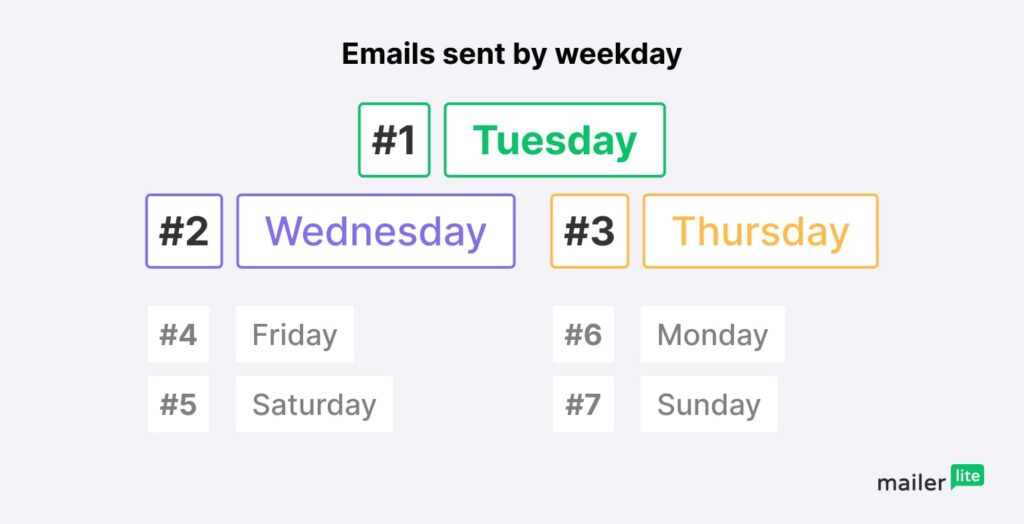
The information indicates that the majority of newsletters are typically sent during weekdays. Tuesday and Wednesday emerge as the top choices for email marketers to dispatch their campaigns, while Sunday and Monday trail behind as the less preferred days
Now, let’s see how this aligns with the average open rates for each day of the week. Check it out below.
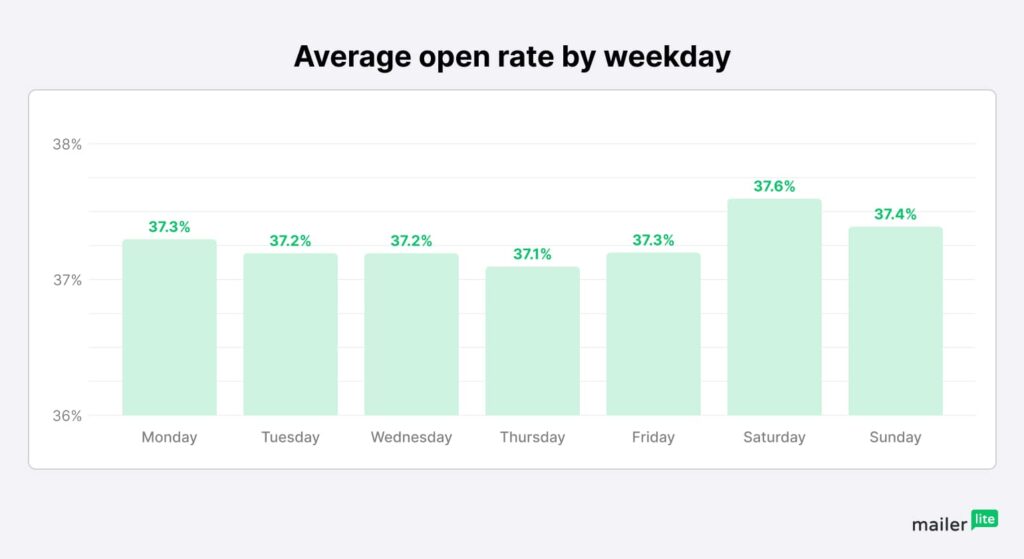
Good news! The rates at which emails are opened remain quite steady throughout the week, with Saturday managing to secure the top position, technically speaking. It’s important to note that Saturdays see fewer emails being sent, and not all open rates are the same. Some individuals may not open their Saturday emails until the following Monday.
To get a more comprehensive understanding of the overall performance of campaigns, we examined the total open rate. In this analysis, all campaigns in the dataset, regardless of their size, contribute equally to the overall open rate.
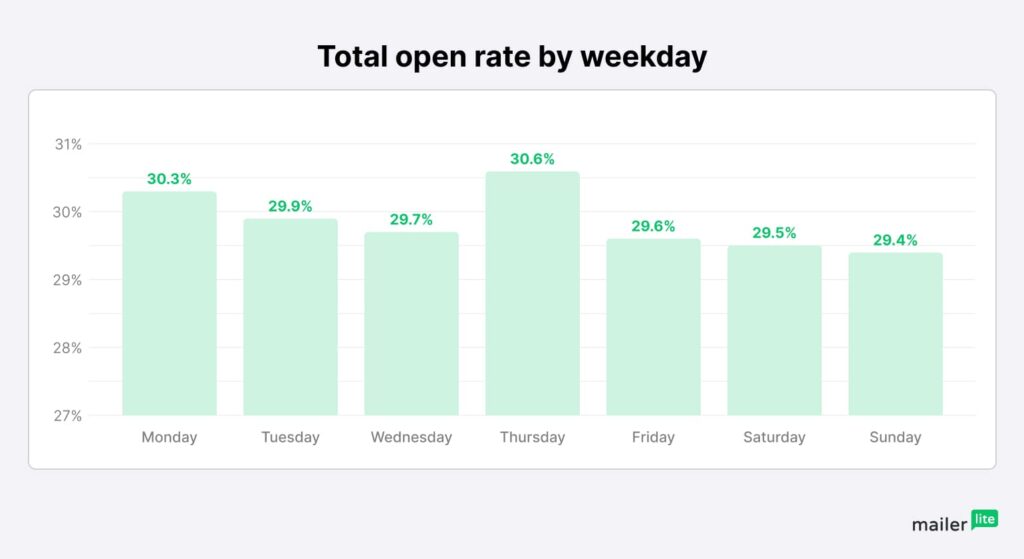
The best choices appear to be Thursday (with a 30.6% total open rate) and Monday (with a 30.3% total open rate).
Given that more emails are sent during weekdays, there’s a chance to stand out if you decide to send emails on weekends. However, it’s important to note that Saturday and Sunday have lower open rates, and most email marketers believe that weekends are not the optimal time to send out a campaign. So, the decision is up to you! It could be a great opportunity or maybe not the best idea.
Perfect send time by Day Hours
According to the research by more than 150 marketing and advertising professionals, we found the best times for their marketing emails. Most of them mentioned that the peak engagement for their emails was between 9 AM to 12 PM and 12 PM to 3 PM.
We were curious if these ideal times varied for each day of the week, like, is Thursday at 10 a.m. the best time? Unfortunately, none of the studies we reviewed provided an answer to this question. The closest insight we found was from Mailerlite’s research, which suggested that 10 a.m. is the optimal time to send email newsletters every day of the week.
However, based on our analysis, if you want to experiment with different email newsletters send times and days, here’s a suggestion we put together using best practices to help you send, measure, learn, and improve:
- Thursday at 10 a.m.
- Tuesday at 9 a.m.
- Wednesday at 8 a.m.
- Monday at 1 pm
- Friday at 3 pm
When you’re uncertain, opt for Smart sending 💡
If you’re unsure about the best time for your audience, make use of MailerLite’s Smart sending feature. It analyzes your subscribers’ behavior and sends emails automatically at the optimal time.
Smart sending is an advanced tool that utilizes past data to figure out the ideal send time for each subscriber. It keeps learning and adjusts to your readers’ habits.
When you choose to send with Smart sending, your campaign is divided into batches, and each subscriber gets the newsletter when they’re most likely to open and engage with it. No guesswork based on others’ data. Just results driven by your own audience.
Ideal timing for sending an email on a Monday.
Based on the data, 11 AM is the prime time when individuals tend to open their emails on a Monday. Additionally, there’s a notable increase in open rates at 6 PM. In the mid-afternoon, open rates dip a bit, possibly as people move past the initial Monday sluggishness and focus on their workday responsibilities.

Ideal timing for sending an email on a Tuesday
Regarding Tuesdays, the highest email opens occur around 12 PM, with an additional boost late at night between 1 AM and 2 AM. There’s a more significant increase at 7 AM to 8 AM, possibly during the wake-up or morning commute period. Open rates dip at 9 AM before gradually rising again to reach the peak at noon. After that, they remain fairly steady before declining around 7 PM.
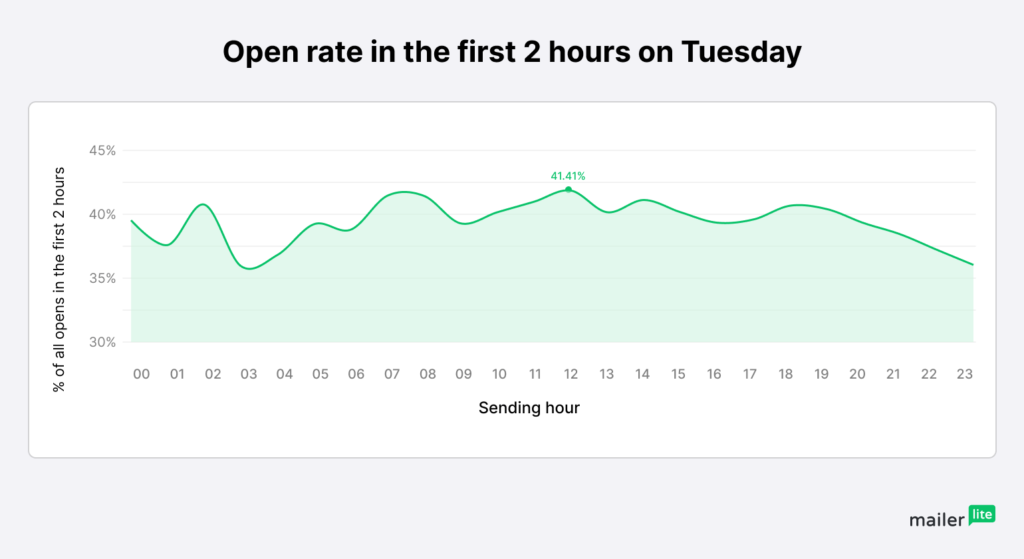
Ideal timing for sending an email on a Wednesday
Once more, 12 PM wins the top spot! The open rates on Wednesdays exhibit a quite similar trend to Tuesdays, but there’s a decline in open rates starting from 2 PM onward. This could be because people are concentrating on completing their midweek tasks, preparing to ease into the end of the week.
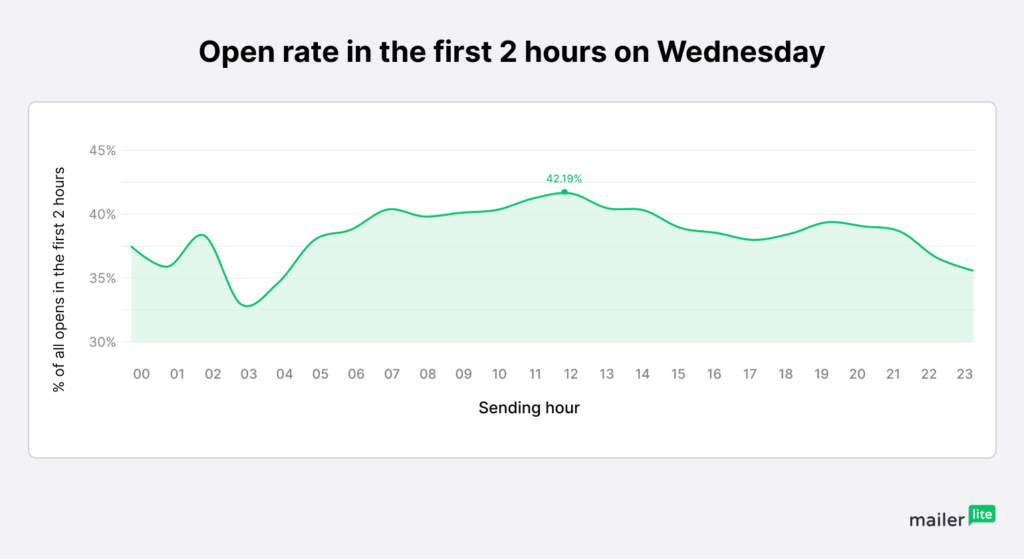
Ideal timing for sending an email on a Thursday
Once more, 12 PM remains the key time for high open rates, with an additional surge at 2 AM and a morning increase between 7 AM and 8 AM. Notably, opens maintain a fairly steady pace throughout the day and only start to decline at 9 PM. This could be attributed to people completing the bulk of their weekly tasks and not initiating new significant projects before the weekend, allowing more time to check their emails.
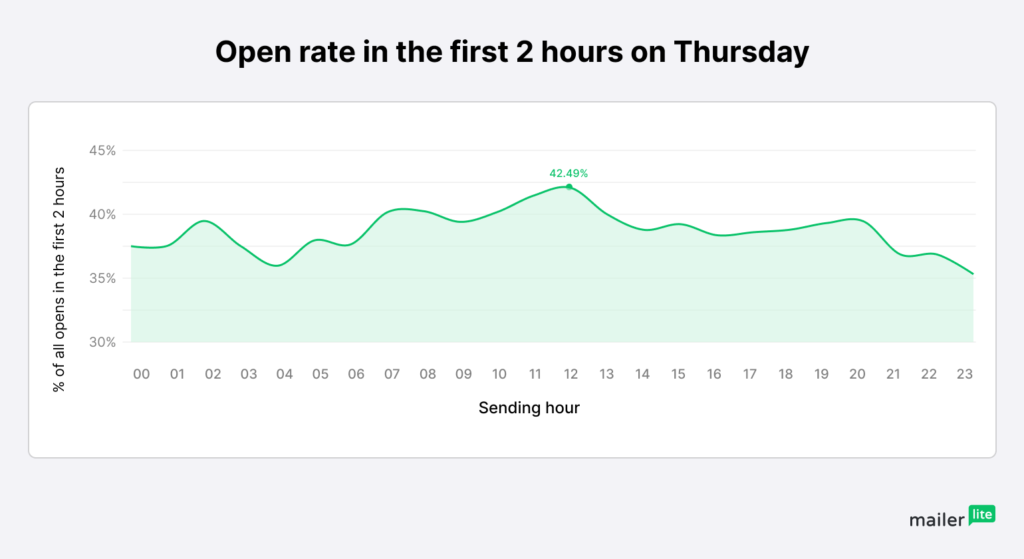
Ideal timing for sending an email on a Friday
Friday mornings show consistently high open rates from 10 AM to 12 PM, with another notable spike around 8 AM. After 2 PM, opens begin to decline. Despite this, Friday can be an intriguing day to send a newsletter because you’re reaching people just before they start their weekend, when they might be more likely to make a purchase or explore new opportunities.
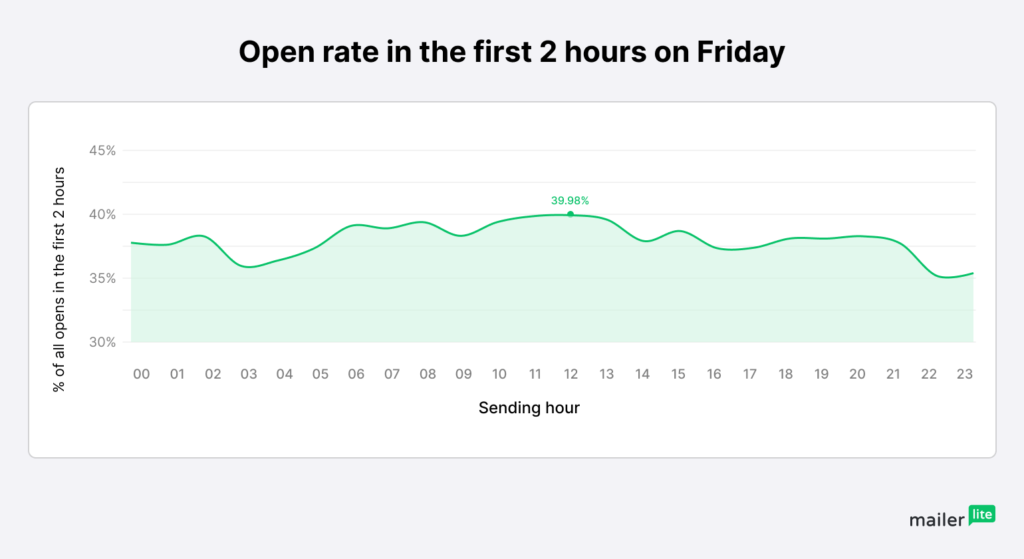
Ideal timing for sending an email on a Saturday
Saturday’s open rate trends closely resemble weekdays, starting with a peak at 7 AM and reaching the highest point around 11 AM. After that, open rates gradually decrease in the afternoon as people disconnect to savor their weekend.
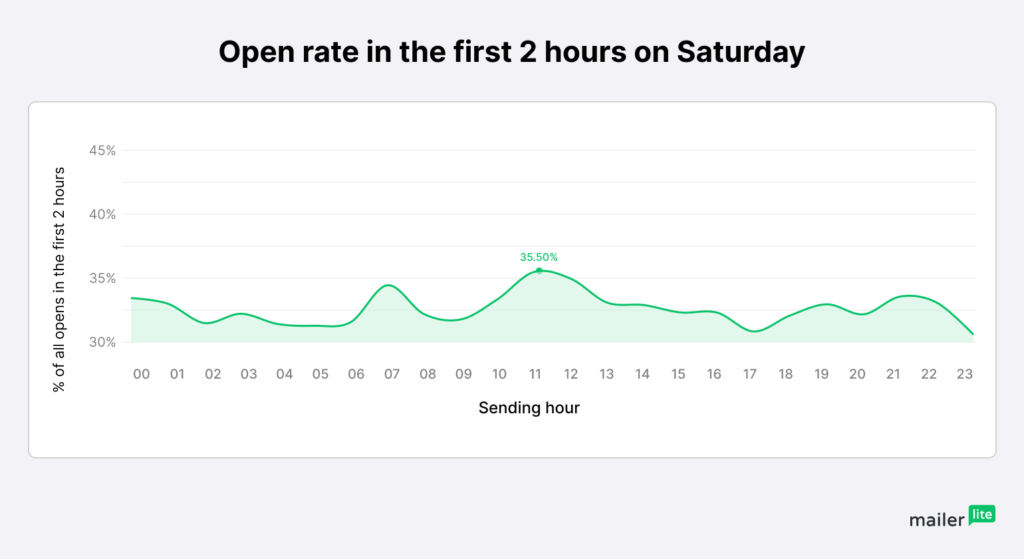
Ideal timing for sending an email on a Sunday
The trend shifts on Sunday. While there’s still an increase around midday, unlike other days, there’s a rise in open rates on Sunday evenings instead of a continuous decline. This likely happens as people begin to get ready for the upcoming workweek. This presents an interesting chance for email marketers since there’s usually less activity on Sundays.
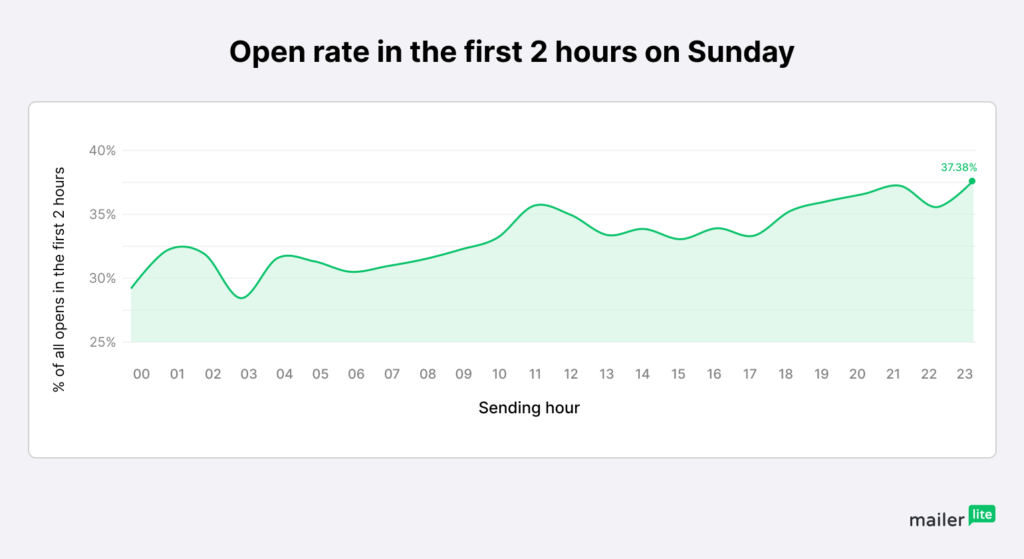
So, when should you send an email?
Our data indicates that open rates remain steady throughout the weekdays, with Mondays and Thursdays standing out as the top performers. Regardless of the chosen day, the window from 11 AM to 12 PM seems to be the optimal time for sending a newsletter.
The statistics also reveal that the least favorable time to send an email is during the hours of 9 PM to 7 AM, when subscribers are winding down for the evening, sleeping, or rushing to get ready for the new day.
But what about those spikes at 2 AM? Is that not the wrong time to send emails? It turns out, midnight emails might not be as much of a mistake as email marketers once believed. To get more insights, we sought answers from our Email Marketing Specialist, Georgia.
Choose a specific time and stick to it consistently.
Sending your newsletter consistently is crucial. People naturally prefer routine, and when you stick to a regular schedule, it builds trust and excitement. Your audience comes to expect your content at a specific time.
While many email marketers send their messages at common times like 15, 30, or 45 minutes past the hour, consider the “sun tactics hack.” This involves sending email newsletters during quieter minutes like 7, 38, or 42 past the hour. By doing this, you reduce the risk of your email newsletters being delayed due to a server overload caused by a high volume of emails sent simultaneously.
Various factors impact when you send your emails!
Deciding the optimal day and time based on data is just one aspect. Look at your overall campaign, as there are other elements that can influence your sending time, such as:
- Email marketing goals
- Providing message content
- About the target audience
1. Email marketing goals
Think about what you want your audience to do when they get the email newsletters. Read it? Click through? Make a purchase?
Here are 3 types of goals that will inform your sending times.
Deep engagement
Do you aim for your subscribers to dedicate significant attention when they click through for a longer experience? Think about sending newsletters on Friday afternoons, evenings, or even weekends. It’s easier to capture attention when fewer or no emails are being sent.
Quick scan
If you’re satisfied with your readers swiftly scanning your newsletter just to keep your brand in their minds, you can send it any time during weekdays. Subscribers will view it and then promptly continue with their day. This is the time when people read emails methodically throughout the day but only respond to the important ones.
Reminder message
For reminding your audience about an event or a webinar, send a follow-up email a day before the event, and then resend it an hour before the event to ensure they remember it.
2. Providing message content
Certain types of emails are more effective when sent at specific times of the day. A clear example is news and media emails – if something noteworthy occurs, ensure prompt delivery.
For B2B email newsletters advertising services or products, the best results occur during regular working hours when subscribers are engaged in their work. On the flip side, a travel agency or author might capture more interest by sending emails after the workday or on weekends. Certain pizza businesses choose to share their deals and coupons around 4:15 PM, precisely when their subscribers start contemplating dinner!
Consider the nature of your message content and schedule it accordingly.
3. Understanding Your Audience
Did you realize that the data about the ‘ideal time to send an email’ is mostly centered on desktop users? It’s essential to check which type of device your subscribers use to access your newsletters. Mobile users tend to be more active later in the evening and on weekends.
Consider the possibility that your main audience isn’t necessarily a typical 9-5 professional but rather someone who works remotely, a stay-at-home parent, or someone who is retired. Use this knowledge to your advantage by understanding their email habits and sending newsletters at times that align best with their preferences.
Best Tools for sending email newsletters
After reviewing your data and figuring out the best times to send your email newsletters, take advantage of the helpful features in email marketing. They’ll make your job much easier!
Smart sending
Smart sending is a fantastic tool, available with the Advanced MailerLite plan. It’s the absolute best way to ensure that your email newsletters reach your audience at the most opportune times. Your email newsletters list consists of real people with different schedules and needs. Instead of trying to find a perfect time for everyone, Smart sending delivers emails individually at a personalized send time for each subscriber.
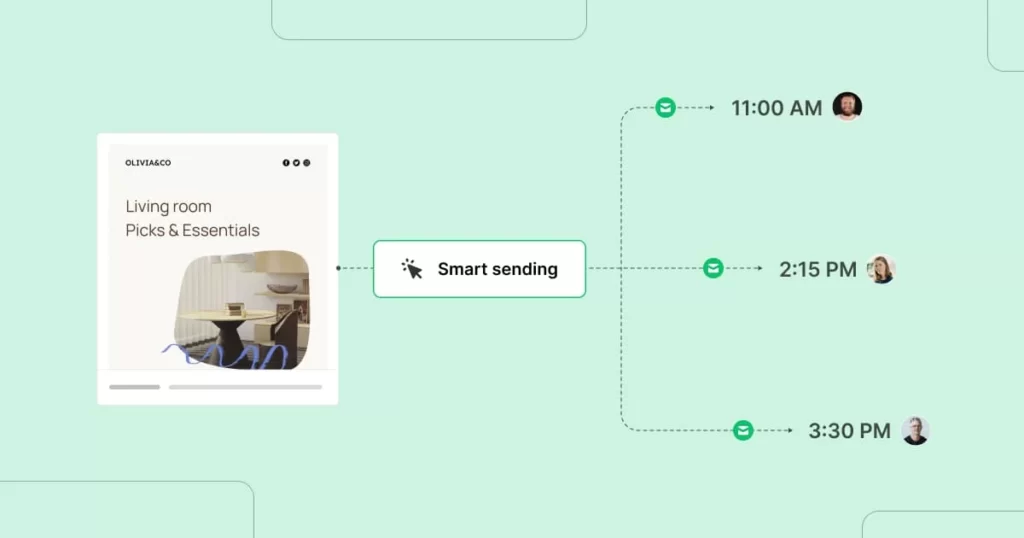
Smart sending uses historical data to figure out the ideal send time for each subscriber and continues to adjust as you use it more. It’s pretty impressive!
Auto-resend
Auto-resend is another useful feature. Since most email opens occur within an hour of receiving the email, you can use auto-resend to re-engage your subscribers effortlessly. This feature automatically resends your email to those who didn’t open it initially.
You can even include a personalized message in the second email, letting people know the content is important. When you resend an unopened email campaigns to those who didn’t open it the first time, the goal is to make them feel like the second email was crafted especially for them.
Send Emails Considering Time Zones
Using MailerLite, you have the option to review ‘opens by location’ to know the geographical locations of your subscribers. When you send emails based on time zones, you avoid the chance of delivering newsletters to your global audience during non-optimal hours. Each reader will get the newsletter at a consistent time in their own time zone. However, please note that Apple Privacy Protection may impact some location and open tracking.
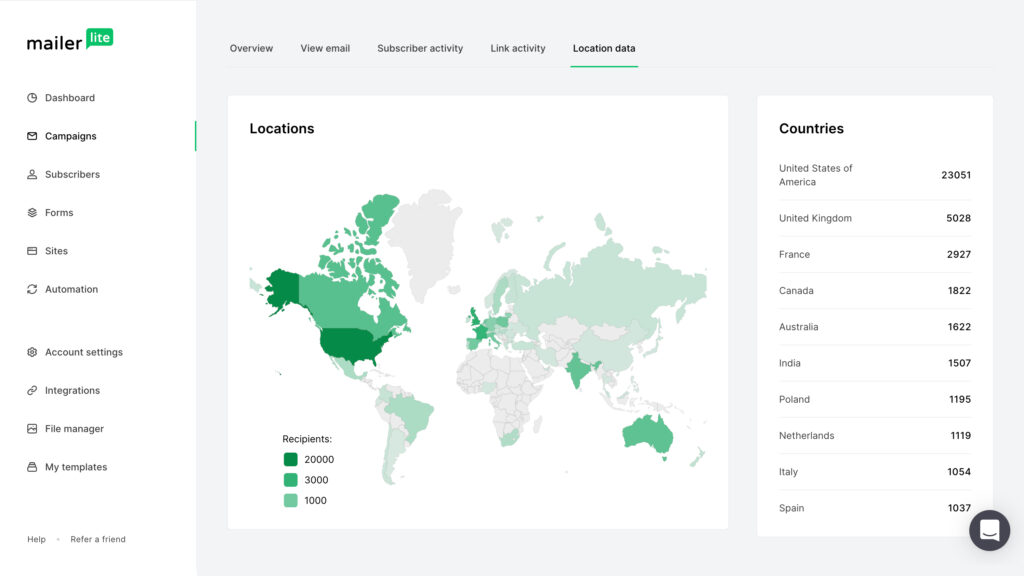
Link Triggers
At times, you can utilize automation triggers to send emails precisely when needed. Instead of figuring out the optimal time to send a newsletter to your entire email list, link triggers send individual emails based on each subscriber’s actions.
When a reader clicks on a link in your email campaign, it can activate another email aligned with the topic they are currently interested in. This eliminates the need for guesswork and allows the subscriber’s actions to determine the ideal time to deliver your message.
A/B Testing and Multivariate Testing
The timing of sending emails is not the only factor affecting open and click rates. Your email’s subject line, sender address, and content also play significant roles. The good news is, you can experiment with these elements and more to identify what generates the most engagement.
A/B testing
involves creating two versions of the same email (e.g., with different subject lines) and sending them to a subset of your audience. The version that yields the highest opens or clicks* is deemed the “winner” and is then sent to the rest of your email list.
Multivariate testing is similar to A/B testing but allows for a more in-depth exploration by testing various combinations of variables for a more advanced understanding of what resonates with your audience.
*Due to the introduction of the Apple Mail Privacy Protection feature on September 20, 2021, we recommend A/B testing based on click rates rather than open rates.
Conclusion for email newsletter sending time
In the grand plan of email marketing, the timing of sending messages is just a small part. What really matters is the content and value you offer to your audience. Even if you send your email at the perfect time, it won’t make a difference if it doesn’t meet other email marketing standards.
If a deadline is approaching and you’re not satisfied with your email, it’s okay to wait until it’s just right. It’s more important to provide a valuable experience than to rush for a specific date and time. When your readers eagerly await your newsletters, the timing becomes less important.
To sum it up, here are the key points about when to send your emails:
Consider your marketing goals, message, and target audience before picking a specific day and time.
Put yourself in your audience’s shoes and consider their daily habits.
Use email marketing tools like auto re-sends and link triggers to optimize your sending strategy.
Remember, having high-quality newsletters is more crucial than finding the perfect timing.
Send newsletters on weekdays for better open and click rates, and on weekends for more focused attention.

